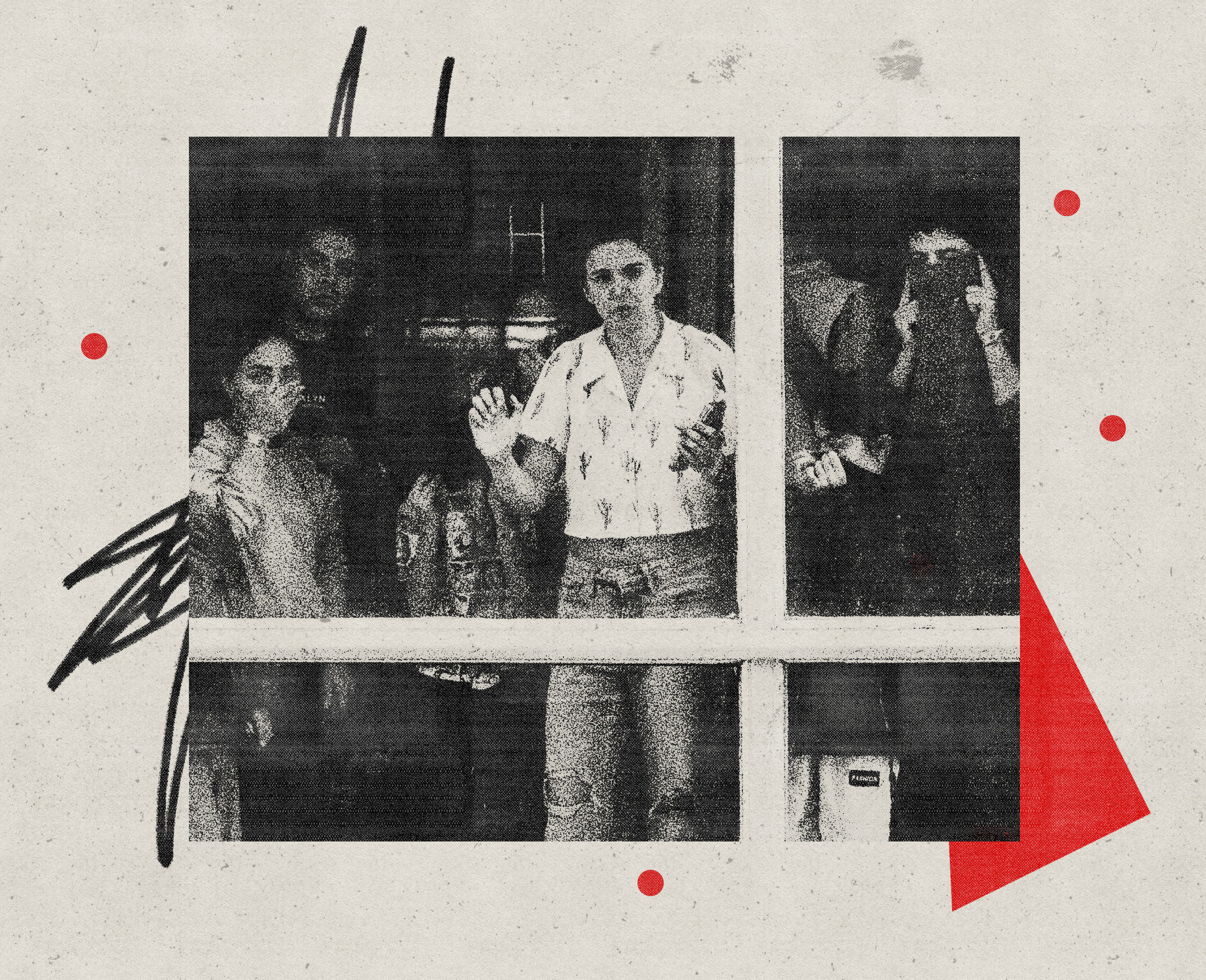Sign up for the daily CJR newsletter.
On a Wednesday in February, rain fell on a C-17 Air Force jet at the Marine Corps base in Miramar, north of San Diego. Officials marched 119 shackled migrants aboard. Just before 1pm, the jet took off, aiming for the equator. The Trump administration would not publicly acknowledge the flight for five days. But as the plane flew south, reporters at the New York Times began work on a story. In Washington, DC, Hamed Aleaziz, the Times’ immigration and Department of Homeland Security reporter, received a tip that a massive military plane was taking migrants—from countries in Asia, Africa, and all over the world—to Panama. In Bogotá, Colombia, Julie Turkewitz, the Andes bureau chief, and Federico Rios, a photographer, began looking at flights to Panama City. In Mexico City, Annie Correal, a Latin America reporter, reached out to her contacts in the Panamanian government.
Even during the crackdown of the first Trump administration, officials had never put asylum seekers and migrants on a deportation flight to a third country, where a foreign government threw them in jail. “This was unprecedented,” Aleaziz said. The story, about a plane full of people detained in a glass hotel, was stunning and complex, given the transcontinental reach and the number of languages involved. The resulting piece was a triumph—but also, a shot across the bow for American journalism. February was just the beginning of Trump “exporting” migrants from around the world not just to Panama, but also to Honduras, Mexico, Guatemala, and El Salvador, where President Nayib Bukele has bragged about “outsourcing” his services, imprisoning people deported from the United States. Among them: Kilmar Ábrego García, a Salvadoran man who had been living in Maryland for fifteen years, until, as government lawyers put it, he was shoved out of the country because of an administrative error.
Ábrego García has received significant press attention as the Trump administration resists court orders to return him, risking a constitutional crisis. In truth, he is among hundreds of migrants, from whom we have heard little. Before this year, reporters already struggled to cover the vast, hard-to-access archipelago of immigrant detention centers across the US. That chain of jails now stretches deep into Latin America. In March, using the Alien Sedition Act—the eighteenth-century law that facilitated Japanese internment during World War II—Trump began speeding up removals, deporting migrants alleged to be gang members without due process. In some cases, the time between arrest and deportation has been just hours, which makes press access to these deportees a near impossibility. Notably, Trump has sent more than 238 Venezuelans to El Salvador, where Bukele has locked them in packed cells in CECOT, a notorious supermax prison, the largest in the world. That arrangement has come with an added benefit for the Trump administration: when immigrants are outside of US borders, American journalists must struggle to keep up with them, to bear witness to what happens, and to bring accountability.
Some reporters have managed to reach migrants by obtaining access through local governments. After Costa Rica received two hundred migrants, in February, the local government quickly transported them to a remote detention center on the border with Panama. Ronny Rojas, a reporter with Noticias Telemundo, was able to get in the jail. He also spoke with detainees from Russia and Afghanistan through a chain-link fence on the detention center’s perimeter. “We are not free to go outside of here. Here, it’s like a jail,” an Afghan father told him. “The children, they cry every day. They cry.” Reporters such as José Olivares, a freelancer working with The Guardian, have done a good job keeping track of flights, by following local reports and government statements (the Honduran government, for one, has claimed that arriving Venezuelan migrants are being sent immediately to Venezuela). For ProPublica, McKenzie Funk produced a stunning investigative feature detailing the experiences of flight attendants, one of whom described a young girl collapsing on board.
Still, journalists can hardly keep up with the velocity of deportations. That is in no small part a function of economics: over the past three decades, foreign bureaus around the world have shuttered, and travel budgets have become nonexistent. During the eighties and nineties, a whole generation of American correspondents reported from Central and South America; today, few English-language reporters live outside of Mexico City, and almost none live in poorer, rural countries such as Guatemala and Honduras. The difference between a deportation—or an “exportation,” as Trump puts it—and a disappearance will be reporters’ ability to keep up. “Putting up blocks and hurdles for journalism is a feature, not a bug,” Correal told me.
The Times—which, along with the Associated Press, is one of the only American outlets with reporters stationed in the vicinity of exported migrants—managed to cover the plight of people held in Panama City. But it was no small feat, and one that may not be widely replicable. (Disclosure: I have worked for the Times as a freelancer covering the US-Mexico border and Texas politics.) “If we didn’t put all of our resources into this, I don’t think we would’ve been able to hear what was happening,” Aleaziz said.
The Friday morning after the jet landed, and the Panamanian government acknowledged the flight, Aleaziz, Correal, and Turkewitz published a news hit, joined by a Mexico City–based investigative reporter named Maria Abi-Habib. The story didn’t include interviews with the passengers on board the flight, however. “You lose so much when you’re not able to get the actual perspective of people experiencing this policy,” Aleaziz said. On the ground in Panama City, Turkewitz and Rios hustled to reach passengers.
Turkewitz and Rios had previously spent months together reporting on the Darién Gap, the hostile stretch of roadless jungle in southern Panama that has turned into a lethal highway for migrants and smugglers, who move northward on foot. Rios, through his own sources, received a tip as to where Panama was holding the migrants—at the Decapolis, a five-star glass high-rise hotel in Panama City. Turkewitz booked a room there. Rios scouted the location using Google Earth, and realized that a hotel across the street would have a clear view of at least some of the rooms. He made a reservation there. That proved prescient: when Turkewitz and Rios entered the Decapolis—they told the hotel they were tourists—staff members explained that the government had booked the entire hotel for migrants. They perched across the street and formulated a plan.
Soon, from the sidewalk, in the heat and humidity, Rios used a telephoto lens to peer into rooms in the Decapolis. He could see families with children and, given what the hotel had told them, he could assume these were the people the US had sent to Panama. Through the glass were scenes of desperation: “There was this woman hitting the window with her shoulder, trying to push it out, but nothing happened,” Rios said. The window was high enough up that, if she had managed to push through, she would have died.
Turkewitz got an idea. She collected a stack of white printer paper and a marker, and began writing a makeshift sign with the words “PRESS” and “WHATSAPP,” along with her phone number. She positioned it on the ground, held down by rocks. Then she and Rios sat on the pavement, waiting for someone to see them. Eventually, the woman who had been pushing at the window noticed. “She came back to the window with this sign saying ‘African,’” Rios said. Soon, other people at the windows began to see the sign, too. Some made gestures to show they had no phones. A couple wrote signs on the window; one woman came to the window with a paper that read “Afghan.” As Turkewitz and Rios watched, she drew her finger across her throat. The two understood what she meant: if she went back to her home country, she would be killed. This complex communication—reporting by semaphore—continued for some time, until Panamanian police noticed the papers and told the journalists they needed to leave. Rios argued with the officers: “It’s not a crime,” he said. After a while, they simply asked the journalists to move to another spot on the street, where Turkewitz and Rios remained until dark.
By the end of the day, Turkewitz and Rios had made contact with migrants, but they had no interview. No one, at that point, managed to call Turkewitz’s number. But back in DC, a colleague had gotten in touch with someone in the Decapolis: Aleaziz, who had spotted a video on Instagram showing a woman sitting in a hotel room. She explained, in Farsi, that she had sought asylum in the US with her children, only to be flown to Panama City, where armed agents now prevented her from leaving. Aleaziz immediately got in touch with his family in Iran. “They were like, ‘Oh, yeah, we saw this on Iranian diaspora media,’” he said. But they didn’t know the origin.
Aleaziz messaged Farnaz Fassihi, the Times’ United Nations bureau chief, based in New York. Fassihi reached out to her sources in Iranian media, and, within hours, she had the number of the woman in the video: an asylum seeker named Artemis Ghasemzadeh. Fassihi started a WhatsApp chat with Ghasemzadeh and Aleaziz. In their first messages to her, the journalists described their own backgrounds as the children of Iranian immigrants. They felt sure, they told me, that doing so helped put Ghasemzadeh at ease. “It pays off to have a diverse staff,” Fassihi said, “to have staff in the newsroom that speak different languages, who follow different communities or are connected to different communities—because, a lot of times, some of these connections help us crack stories.”
The three made plans for a call on Saturday morning. But then, later on Friday evening, Ghasemzadeh called Fassihi in alarm, telling her that the Panamanians had begun confiscating cellphones. This was Valentine’s Day night, and Fassihi and Aleaziz were both out with their families. “We both sort of abandoned our plans and jumped on a call,” Fassihi said. For two and a half hours, the two interviewed Ghasemzadeh. At one point, she passed around her phone to members of her extended family. Their story appeared the next week in a powerful profile. Ghasemzadeh was a Christian convert, and she feared she would face the death penalty if returned to Iran. In turn-by-turn detail, Ghasemzadeh described the deportation flight and the conditions in the hotel.
After getting off the call with Ghasemzadeh, Aleaziz and Fassihi were again able to take advantage of the Times’ considerable resources: another Times staffer, in Paris, quickly got to work producing an English-language version of the Farsi transcript. Aleaziz and Fassihi shared the most important details with Turkewtiz and Rios down in Panama. In a large WhatsApp group, the reporters and Ghasemzadeh organized one of the most poignant news photos of 2025. As Rios trained his lens on Ghasemzadeh’s room, she and her family gathered at floor-length windows; using lipstick, she wrote on the glass, “HELP US.”
Continuing to get these images, and these stories, will require reporters on the ground more or less permanently in at least five different Latin American countries. The difficulty the Times journalists experienced, even in downtown Panama City, shows how hard sustaining that presence will be. On Saturday, Turkewtiz and Rios stood on a balcony of their hotel facing the Decapolis and continued their hand signals—but, this time, they also had some migrants’ numbers. Ghasemzadeh and others had managed to keep phones. A Chinese man, whom the reporters named only as Mr. Wang, came to the window with a Bible and a crucifix. As Rios snapped photos, Mr. Wang read Turkewitz’s number off the papers on the ground, and sent her a WhatsApp message. At first, Turkewitz used Google Translate. Then she asked on the Times’ editorial Slack if any Mandarin speakers could help her report; Ang Li, a video journalist, jumped to the task. Over WhatsApp, the reporters learned that Mr. Wang, too, feared a prison sentence or the death penalty for his Christian conversion if he returned to China.
Rios anticipated—correctly, as it turned out—that the Decapolis would turn off the Wi-Fi once it realized the deportees were communicating with reporters. He shared the Wi-FI credentials for his and Turkewitz’s hotel from across the street so they could all continue talking. The impact was obvious: the voices of deportees dominated the cable news cycle for a week. The story also contained a key detail: Before, “we weren’t able to get anything officially from the US,” Aleaziz said. But after getting those accounts, when the reporters reached out to the Trump administration for comment, the government finally acknowledged that the flight had happened.
Still, officials never allowed journalists access to the hotel. And on Tuesday night, Ghasemzadeh again messaged the reporters in alarm: “They’re moving us,” she told them. Rios had another clever idea: he asked Ghasemzadeh to share her location on her phone. As the migrants were led out of the hotel, the Times reporters followed her dot on a map. Turkewitz, who understood Panamanian geography well, could tell where they were being taken: toward the Darién Gap, to a jail camp in the jungle.
Press freedom laws vary notably across Latin America. Reporters Sans Frontières, in its 2024 World Press Freedom index, flagged Panama as “problematic,” and noted that the environment for journalism has deteriorated dramatically in recent years. Still, Panama ranks far above El Salvador, which RSF charted as one of the most difficult countries in the world to do journalism. El Faro, one of El Salvador’s most storied newspapers, survived twenty-five years of gang wars and corruption scandals until a campaign of threats and legal harassment under Bukele forced the outlet to move its headquarters to Costa Rica, in 2023. After the Trump administration sent hundreds of immigrants to El Salvador’s CECOT, it seemed unlikely reporters would be granted access—but, for better or worse, the Salvadoran government has been eager to show off the draconian conditions inside. Philip Holsinger, a photojournalist who has spent over a year reporting on El Salvador, was allowed to follow the prisoners from the airport tarmac all the way to prison, for Time magazine. His images are haunting: they show a terrified, shackled man forced to lie face down as guards scream, a man in chains having his head forcibly shaved. Weeks later, in early April, CBS 60 Minutes correspondents toured CECOT with their cameras, providing Americans a view into the conditions that Trump had subjected Venezuelan deportees—75 percent of whom lacked criminal records—to suffer indefinitely. Much of this was spectacle, of course, choreographed by authorities. The Salvadoran government has prevented any interviews with the “exportees” themselves, all of whom are being held without charge. With no rule of law, nothing will stop the government from holding them the rest of their lives.
Journalists have never been able to cover every deportation. In March 2020, as COVID shut down the world, I was reporting from a family detention center in South Texas. From a parking lot across the road, I watched white prison buses, packed with families, leave the jail multiple times a day, headed for the Mexican border. It remains a painful professional regret that I never learned what happened to those families, expelled with their young children, during the chaos of the early pandemic. Something, though, about these new “exportations” is different. In places such as El Salvador, the US ought to be accountable for conditions “offshore” exportees face. And with due process eroded, reporters are among the last checks that can ensure the government isn’t illegally deporting anyone—including US citizens. On April 25, for instance, the American Civil Liberties Union raised the alarm that three US-citizen children—ages two, four, and seven—had been deported along with their parents. One of the families had allegedly been held less than twenty-four hours prior to being deported, and the ACLU claims that Immigration and Customs Enforcement agents did not allow the parents contact with attorneys.
The work this moment requires from reporters is immense and, as Correal noted, reporters need to keep up with these deportations not only to understand what’s happening to the deportees, but to elucidate US policy in Latin America. It can be deeply frustrating. When I first called Turkewitz and Rios, in February, they were in a hotel in the small town outside the Panamanian jungle jail, waiting to see if they would get access. They never did. As they stayed in patient expectation, I asked them if any outlet—even the Times—had the resources to track down future “exportation” flights, to Panama and the other countries that the Trump administration persuaded to accept deportees from around the world. Turkewitz shared my concern, but turned the question around, as she wondered whether anyone could predict Trump’s policies. Would these kinds of flights continue for years, or appear as just a blip early in his term? The Times team would do all they could, she said. “The important thing for us is that these people don’t just disappear,” she told me. “Once they’re deported from the US, it’s important for us to find out what is happening to them, what are the results of US policies.”
Editor’s Note: This story has been updated to clarify where Correal began reporting.
Has America ever needed a media defender more than now? Help us by joining CJR today.







